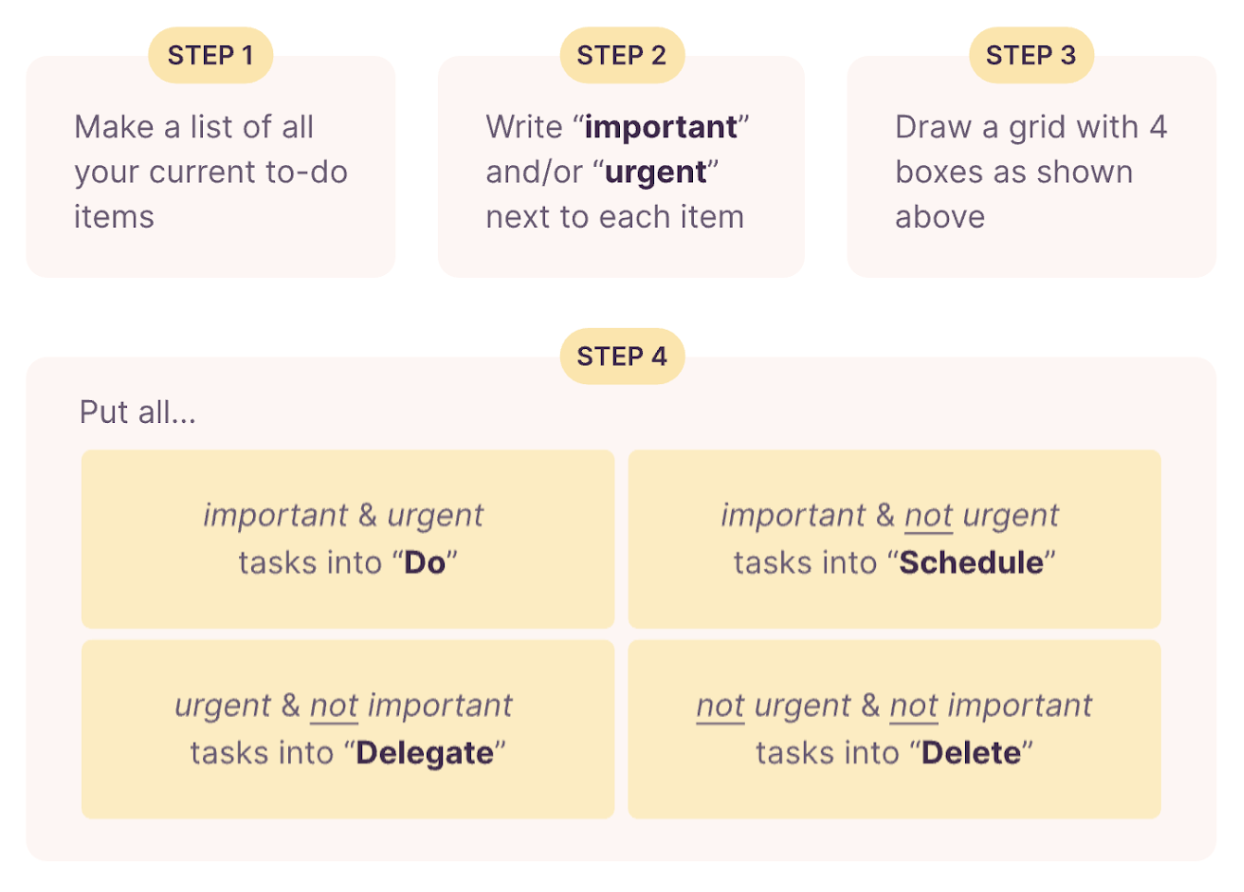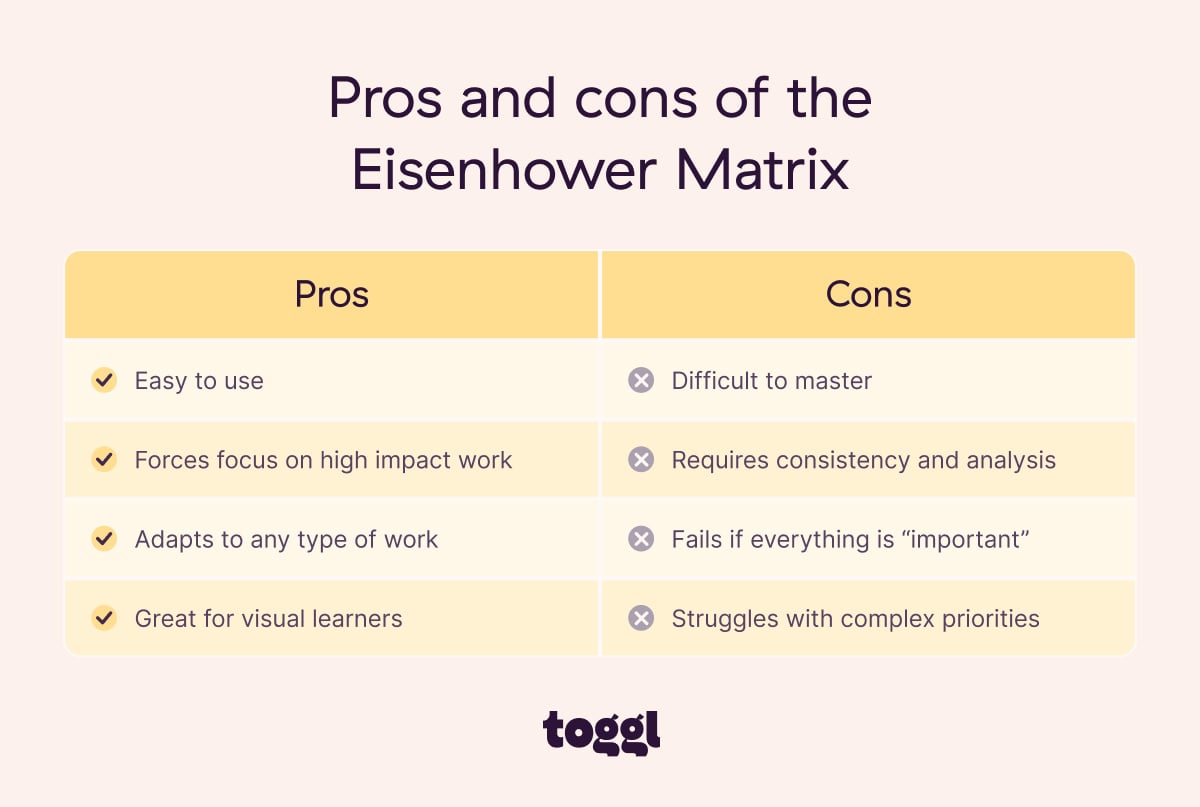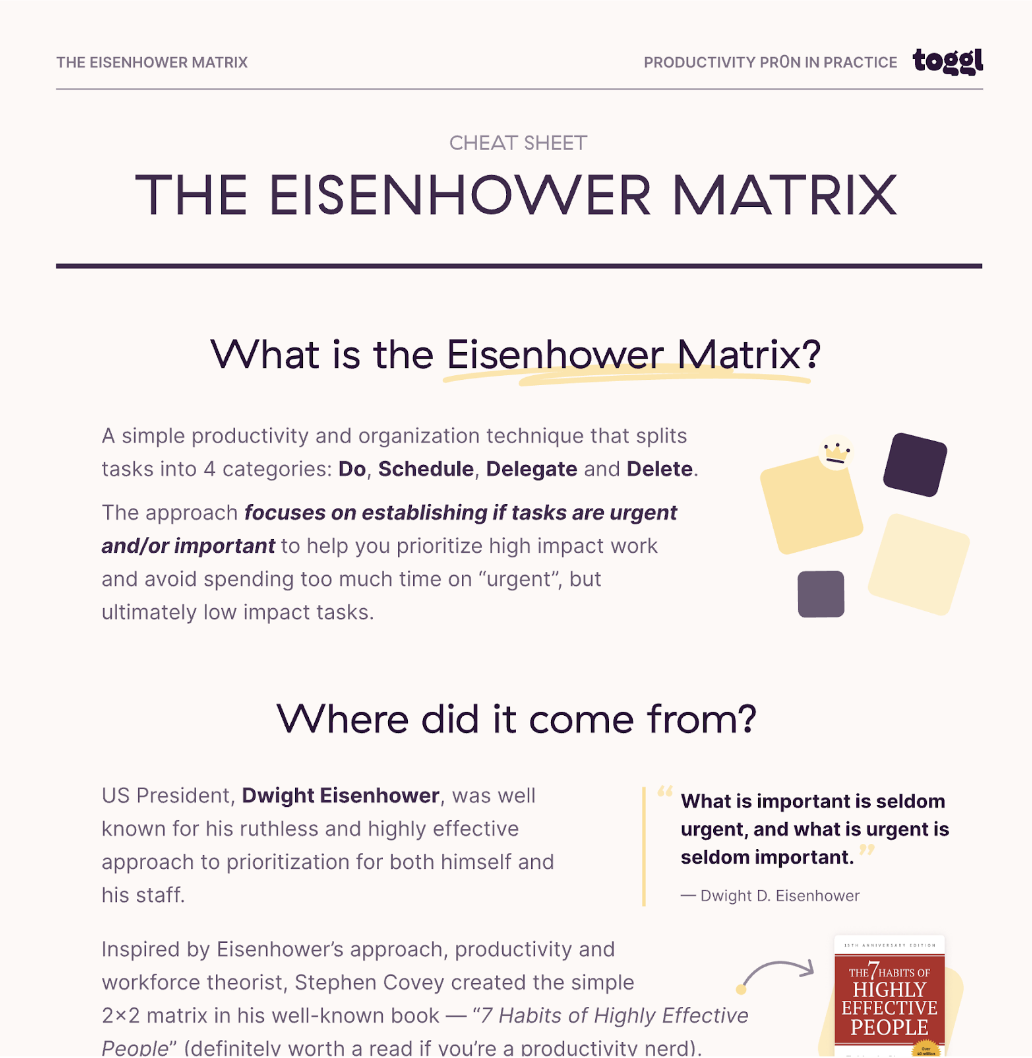This deep dive is part of our “Productivity Pr0n in Practice” series, where we examine some of the leading go-to productivity hacks, the theory behind them, and try to establish whether they actually work in real life! Read on to discover how the Eisenhower Matrix can make you as productive as a US president…
It’s (really) cliche to talk about how everyone has 24 hours in a day.
Lots of us want to maximize those 24 hours and get things done. We search for the perfect system to help us do more with the same daily time crunch every other human has.
So… why can some people achieve way more in 24 hours than others? 🤔
To answer this question, I thought about what a task list looked like for the person in charge of the largest organization on the planet — the President of the United States.
As it turns out, Presidents also struggle to tick off their task lists.

The 24th President of the United States — Dwight D. Eisenhower — even created his own productivity method to help his team get more stuff done. Known as The Eisenhower Matrix, it uses clear parameters to help people prioritize tasks, decide what to delegate — and what to delete.
Decades later, everyone from freelancers to team leaders to world leaders still rely on the Eisenhower Matrix to maximize every hour in their day.
Ready to be as productive as a President? 🙂
Want a TL;DR of how to put the Eisenhower Matrix into practice? 🤔
Grab our handy Cheat Sheet here
How The Eisenhower Matrix turned into a productivity powerhouse
We’ve all been there. A huge to-do list and no idea where to start 😬
It’s a small comfort that everyone from you and I to the President of the United States can hit a wall when deciding what task to tackle first.
After he took office in the 1950s, Eisenhower knew he needed a better way to juggle his growing task list in the White House. So, he created a decision-making tool called The Eisenhower Matrix to help him work through it.
Since then, the method has been popularized in project management spaces, most notably by Stephen Covey’s 7 Habits Of Highly Effective People, which made its way onto the bookshelves in the late 1980s.
Now, you might recognize the method as this:

It’s (relatively) straightforward:
- Tasks are put into one of four quadrants: Do, Schedule, Delegate and Delete
- You must then decide which tasks belong where to help prioritize high-impact work
- Any tasks that fall into the top quadrants take priority. Those in the bottom quadrants (urgent but ultimately low-impact tasks) can be delegated or deleted to free up time
The reason many businesses and government agencies still use the Eisenhower Matrix to tackle projects and optimize operations some 70 years later is simple—it works.
Just ask the 44th President, Barack Obama. He mused that no task or decision that landed on his desk had an “easy, tidy answer”.
“When you have a tough, almost unsolvable decision to make, you don’t just want people to tell you what you want to hear,” he once said.

However, while Obama had plenty of tasks that fell into Quadrant 1 of Eisenhower’s Matrix (urgent and important), he also knew it was important to carve out time for non-urgent but equally important work.
That’s why every night, he spent an hour tackling a task hardly anyone would expect to be on a President’s to-do list: answering people’s handwritten letters… by writing them back ✍️
Obama’s mailbox received 10,000 letters each day. Personally replying to a handful of them every night was a task he decided to put in Quadrant 2 of Eisenhower’s matrix—not urgent but important.
So, why did this task matter so much to him? And why didn’t Obama delegate it… or simply file the letters away? 🤔
He said it was important for people to know he understood them.
“Looking back, the number of complex situations I had to adjudicate seems remarkable — that’s the job of the President of the United States. But the truth is that, even as regular Americans going through our days, we face countless decisions.
The best we can do is find a framework that helps us consider our choices, knowing that there may not be one perfect answer. That way, we can rest a little easier knowing that we did the best we could in the circumstances, come what may.”
If the busiest man on the planet can find time to run a superpower and answer his mail—you can check off your to-do list.
All it takes is the right productivity framework 🤓
Why the best leaders use delegation as a productivity superpower
Often the most important step for productivity is deciding what tasks are valuable enough to warrant your time and attention, whether someone should tackle them for you—or whether you should even do them at all.
Again, let’s take some lessons from the Presidents.
The 33rd President of the United States, Harry Truman, famously displayed a plaque on his desk that read “The Buck Stops Here.”
Even so, Truman knew the value of decision-making and delegating so he had enough time to focus on the most important tasks that reached his desk. As a result, Truman was well known for putting tasks in Quadrant 3 of his Eisenhower Matrix—urgent but not important. Meaning, it wasn’t important enough for him to spend time on them, but he trusted someone on his team enough to delegate it.
Eisenhower himself went one step further.
He expected his staff to understand the difference between important and unimportant decisions and trained them to self-delegate tasks. This helped Eisenhower build a self-reliant team capable of making decisions and ticking tasks off without him having to micromanage. As a result, he had more time and energy for the tasks in the top quadrants of his decision matrix .
So, what can you learn from how these leaders approached their (very important) to-do lists? 🤔
🙋Know Yourself
As a team lead, manager, or project manager, your work is never done. Just like Eisenhower or Truman, all leaders must rely on (and trust) their team to get stuff done. Good management goes beyond supervision.
Lean on your team to think for you. One of the most enduring lessons a manager can learn is you will never, ever check everything off your department’s to-do list. Instead, trust your staff to take care of things on their own—without micromanagement.
🙅Know Your Limits
Let go of the idea that you can magically complete, catch-up on, and finish even your lowest-priority work.
To work in concert with your team members and achieve an Eisenhower-like level of compartmentalization, you must communicate your expectations. Train your people to know the difference between tasks and decisions they should make on their own—and what they should pass on to you.
When you feel overwhelmed by your workload, the Eisenhower Matrix is a decision-making method to free yourself. It’s time to focus only on what matters most—and delegate, schedule, or set aside the items on your task list.
Let’s take a look at how to do just that 👇
How to create an Eisenhower Decision Matrix
Eisenhower created his famous system to teach his trusted team about prioritization, delegation, and triage.
It’s still a great strategy to break a large to-do list down into priorities for yourself and your team. First, think about how much detail you want to include in each task and how it will translate to the quadrant.
Here’s an example:
❌Reply to John’s email
This task is too granular. If you have 50 emails to answer, it will require 50 separate tasks on your to-do list.
✅Review and reply to all unread emails
This task is specific without being too specific. Reviewing/replying to unread emails only will help narrow your focus
Once tasks are narrowed down with enough details, start to build your to-do list with this quick checklist:

Now, take a look at your results:
- Is one box far fuller than the rest?
- Is one empty? If so, re-evaluate your definitions of Important and Urgent.
- Is everything on that list really Important?
- Can some items be redefined as Not Urgent?
Once you have your quadrant boxes balanced, here’s how to tackle them 👇
Use The Eisenhower Matrix to write a to-do list (you will actually do)
Got your Eisenhower Matrix from the last step in front of you?
Great. Here’s how to approach the tasks in each quadrant:
Quadrant 1: Urgent and Important
- 🚶Next steps: Do it Now. To be clear, do it as soon as you finish reading this article. Who knows, you may discover an even-more-urgent task!
- 🤔But first: If you find yourself working on a lot of Q1 tasks, rethink your employees’ skills and decision-making levels. Over time, aim to delegate Q1 tasks to Q3!
Quadrant 2: Important and Not Urgent
- 🚶Next steps: Schedule and Plan. You can’t trust these important tasks and decisions to someone else, but they don’t need to be done right away.
- 🤔But first: Schedule these and put them out of your mind completely. Save all of your focus for Q1 tasks; once you’ve put out all the fires, take another glance at Q2.
Quadrant 3: Urgent but Not Important
- 🚶Next steps: Delegate. Give your team members a chance to prove themselves by handling urgent (but not life-or-death tasks).
- 🤔But first: Learn to separate the Q1 and Q3 parts of a task. Be honest—you don’t have to do all of the work personally, do you? For example, you may want to greet that big new client in person, but you can ask a team member to show them around.
Quadrant 4: Not Urgent and Not Important
- 🚶Next steps: Delete. These tasks only clutter up your to-do list and your team’s agenda.
- 🤔But first: Archive related messages and files for reference, just in case they become more Important or Urgent in the future. Remember, it’s better to just take a break than spend any time/energy on these items.
By now, you should have organized and delegated tasks and decisions to your team members.
So, how do you manage your time and ensure things don’t get out of control again?
To create a long-lasting and stable team, you must reflect on your ability to delegate and if tasks really belong in their chosen quadrants. The best way to figure out the flaws in your Eisenhower Matrix approach is to put the method to a real-life test.
Pros and Cons of the Eisenhower Matrix

Real-life test: A week with the Eisenhower Matrix
By now, you know the Eisenhower Matrix is a powerful management tool for far more than slicing and dicing your to-do lists.
Whether you are alone or have a skilled team, aim to create a matrix for each day of your week. This matrix will outline each task you want to do that day, delegate work to your team and put the unimportant stuff in the trash.
At the end of the week, sit down for the last hour of the day and review your results:
- If you’re leading your team through this exercise, ask them where they spent most of their time
- Have them look at the ways their definitions of Urgent and Important changed over the week
- Identify which days of the week had the most Urgency or Non-Urgency
- Encourage your team (and yourself) to untangle their workflows, avoid unnecessary tasks, and save energy for when Urgent tasks pop up
Here’s our last tip: the sweet spot for this method is to spend most of your time in Quadrant 2 (Important but Not Urgent). If this isn’t the case, here’s why this could lead to the productivity method failing:
- If you’re always in Quadrant 1, you can burn out. The way to avoid this is to hire more staff, reduce your workload, or rethink what tasks you tag as Urgent
- If you focus on tasks in Quadrant 3, it’s a signal you are wasting time on tasks that can be delegated or outsourced.
- If you’re in Quadrant 4, just take some time off; it’s better to take a break than to pretend to work by addressing Q4 tasks.
Experiment with this method for a week. If it works, implement it for the foreseeable future, tweak the quadrant as necessary and watch your productivity skyrocket 🚀




![Why the Brain Sucks at Time Management [Comic]](https://toggl.com/blog/wp-content/uploads/2015/02/perception-of-time-673x404.jpg)
